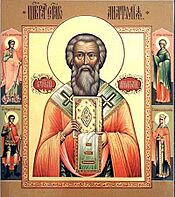Anatolius of Constantinople facts for kids
Quick facts for kids SaintAnatolius |
|
|---|---|

Icon of Patriarch Anatolius of Constantinople
|
|
| Bishop and Confessor; Patriarch of Constantinople | |
| Born | ? Alexandria, Egypt |
| Died | 3 July 458 Constantinople, Eastern Roman Empire (now Istanbul, Turkey) |
| Venerated in | Eastern Orthodox Church; Roman Catholic Church |
| Feast | 3 July |
| Attributes | Vested as a bishop with omophorion, holding a Gospel Book |
| Anatolius of Constantinople | |
|---|---|
| Ecumenical Patriarch of Constantinople | |
| Enthroned | 449 |
| Reign ended | 458 |
| Personal details | |
| Denomination | Chalcedonian Christianity |
Anatolius (who died on July 3, 458) was an important leader of the church in Constantinople. He served as the Patriarch of Constantinople from 451 until his death. Both the Orthodox and Roman Catholic Churches consider him a saint.
Contents
Life of Anatolius
Anatolius was born in Alexandria, a famous city in Egypt. He became a church helper, called a deacon, under Cyril of Alexandria. Anatolius was also at an important church meeting in 431. This meeting was called the Third Ecumenical Council, held in a city named Ephesus.
Becoming Patriarch
Anatolius became the Patriarch of Constantinople with the help of Pope Dioscorus I of Alexandria. This happened after the previous leader, Flavian, was removed. Before becoming Patriarch, Anatolius was a special representative for Dioscorus. He worked with Emperor Theodosius II in Constantinople.
Some people thought Anatolius might follow the ideas of a group called the Eutychians. These ideas were considered wrong by the church. To show he was against these ideas, Anatolius publicly spoke out. He condemned the teachings of Eutyches and also those of Nestorius. He agreed with the letters written by Cyril and Pope Leo I.
The Council of Chalcedon
Anatolius worked with Pope Leo I to ask Emperor Marcian to call a big church meeting. This meeting was meant to deal with Dioscorus and the Eutychians. This important meeting became known as the Council of Chalcedon.
Anatolius helped lead this council along with representatives from Rome. At the end of the council, a famous rule was made. This rule, called the 28th canon, said that Constantinople was equal in importance to Rome. It stated that Constantinople was "second in honor and power" only to the Bishop of Rome. This new rule changed the traditional order of power for older church centers like Antioch and Alexandria. This led to some disagreements between Anatolius and the Pope in Rome.
Later Years and Death
After the Council of Chalcedon, Anatolius received a letter from bishops in Egypt. They asked for his help against a person named Timothy, who was trying to take over as the leader in Alexandria. Anatolius then wrote to Emperor Leo about Timothy.
Anatolius is also known for crowning Emperor Leo I. This was the first time a church leader crowned an emperor. When Anatolius was very sick, he was healed by Daniel the Stylite. Daniel was a holy man who lived on top of a pillar. He came to Constantinople to see Anatolius.
Some followers of Dioscorus are believed to have killed Anatolius in 458. Anatolius is also remembered for writing some church songs, called hymns.
See also
 In Spanish: Anatolio de Constantinopla para niños
In Spanish: Anatolio de Constantinopla para niños

